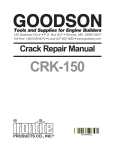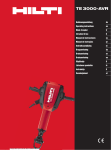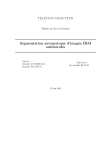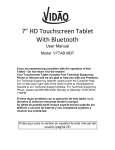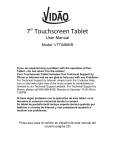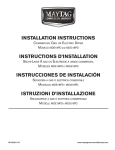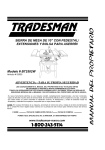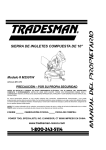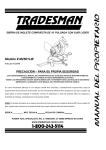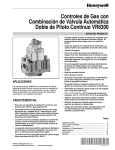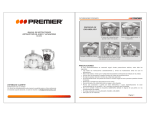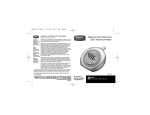Download seal-all™ resurfacing the casting
Transcript
SEAL-ALL™ After years of research and development, here is a way to impregnate and seal porosity, pin holes and fine cracks in cast iron and cast aluminum cylinder heads and motor blocks. This product makes all ceramic seals obsolete. No circulators, no heaters, or special equipment required. Just pour Seal-All™ into the water jacket. Wait one hour, or apply 10 PSI for 1 minute to penetrate the leak. Pour excess out and store in the original bottle to reuse. Cure for 1 hour at 200°F or 8 hours at 72°F. Seal-All™ outperforms ceramic sealants. It cross-links with oxides (rust) inside the water jackets to form a tough, flexible lining that seals leaks and contains cooling systme pressures. Not effected by water or coolant (anti-freeze). It prevents rust and corrosion; insulates and distributes heat evenly through the casting. Seals porosity it welds and withstands engine operating temperatures. Seal-All™ is safe, easy, permanent and economical. RESURFACING THE CASTING Having completed adding and moving metal in the casting to close the crack, the surface of the casting should then be restored to its original condition. For this purpose, Goodson supplies drills, rotary files, abrasive grinding stones, and grinding mandrels and sleeves. See our most current catalog for complete listings, or call for more information. Toll-free 1-800-533-8010 or direct at 507-452-1830. © 1999, GOODSON SHOP SUPPLIES P.O. BOX 847, AIRPORT INDUSTRIAL PARK, WINONA, MN 55987-0847 CR-MANUAL Page 8 Order No. CPS-32 (32 oz. bottle) Also available in a 1 gallon bottle, Order No. CPS-128. Crack Repair Manual CRK-150/350 PRODUCTS CO., INC.® CR-MANUAL INTRODUCTION The Goodson crack repair process is a cold repair process for repairing cracks in castings by adding metal and by moving the metal in the casting to close the crack. Just as castings vary in dimensions, in points of stress, and in the development of cracks, likewise, the application of the crack repair process must be both flexible and adaptable. It is necessary initially to understand the basics of the cold crack repair process. In applying the process during the repair of casting, techniques for repairing specific cracks will evolve naturally within the skill and experience of the particular operator. This manual will discuss the repair of cracks generally, the principles involved, and the tools and materials used. A few examples will be given of the crack repair process applied to engine castings and the injector seat area of diesel engine heads. It is our hope in preparing and presenting this crack repair manual to be of further service to the engine repair and rebuilding industry. PRELIMINARY DISCUSSION The crack repair process for cracks in metal castings involves four basic steps: 1. Detection of the crack - determining the exact location and extent of the crack. 2. Relieving the stress in the casting in the area of the crack 3. Adding and moving metal in such a way as to close the crack 4. Refinishing the surface of the repaired casting. A fundamental advantage of the crack repair process is that metal is added and moved to close the crack without subjecting the casting to high temperature changes that take place in the welding process. This avoids altering the physical characteristics of the metal in the casting. For example, the heat treating characteristics of the original casting are not altered when a crack in the casting is repaired through the crack repair process. The hardness of the casting remains exactly as it was before the repair of the crack. This can be of importance in many instances. For example, in some diesel engine heads where the injector hold is threaded, welding that area of the casting may reduce the hardness of the casting and increase the likelihood of subsequent stripping of the threads in the injector hole when the injector chamber is torqued into place. A repair of the injector area through the crack repair process will avoid the effects of such temperature changes. The crack repair process is not new. It has been in use successfully for many years. In addition to the normal repair of cracks on flat surfaces of engine heads and block, one of the more common uses of the process has been the repair and replacement of cracked and worn injector seat area in Cummins and GMC Detroit Diesel engine heads. The cracked or worn area is reamed out and tapped, then a tapered threaded plug is torqued into place. The area is resurfaced and drilled, then a new seat is cut to match the original configuration of the injector head. This application will be discussed in detail later in the manual. CR-MANUAL Page 2 and move the metal by torquing in of the plugs as well as by peening. Using a center punch, spot along both sides of the crack where it is intended to drill. Tap and install the tapered plugs. The holes should be spotted very close to the crack about 1/8” apart in a lacing fashion alternately on the two sides of the crack. After spotting the locations for the plugs along the line of the crack, and before beginning to drill holes for the plugs, the entire crack should be peened, always peening toward the center of the crack. After the crack has been peened, then drill and tap the holes for the plugs. The plugs should now be torqued into place. Torque the plugs in a concurrent pattern. Do not torque in one plug all the way and then move on to the next one. After the plugs are torqued into place, cut off the part of the plugs extending above the surface. Notch them with a small saw about 1/16” above the surface and break them off by tapping lightly with a small hammer. Now, the crack should be peened again. In addition, the stub ends of the plugs should be peened. In this type of repair, the crack is closed only by the moving of the metal in the casting caused by torquing in plugs alongside of the crack and by the peening. This is why the location of the plugs and the peening of the casting are very important. This photo shows a repair with the holes drilled and tapped. Here, where the metal in the casing is relatively thin, it is not usually necessary to use a tapered reamer before tapping the holes. This photo shows a repair with plugs installed and peened ready for resurfacing the casting. CERAMIC SEAL Ceramic seal, when properly applied, leaves a fine ceramic coating on the inside of the casting, which serves to close porosity and the inside of minor cracks. It is applied to the casting after the crack repair process is completed to give it a finishing touch and added assurance that the crack is closed. The head or block is remounted on a pressure tester and the water ports are sealed so that the casting can be pressurized. After pressurizing the head or block and confirming the quality of your crack repair, secure the outlet and inlet hoses on the circulator and circulate the ceramic seal through the casting at the temperature supplied by the circulator. After circulating the casting for a period of 15 to 30 minutes, close off the return valve and then depress the air pressure button, holding it down for a few seconds and then releasing it. This pressure forces the ceramic seal in the casting out into the interior of any cracks and into any porosity in the interior of the casting. Now, turn the head over, open the circulator return valve and press the air pressure button for only a few seconds. This will force the remaining liquid ceramic seal in the casting back into the circulator tank. Remove casting and set it to the side to allow the ceramic seal in the interior of the casting to set or “fix.” After a period of time, the ceramic seal will fix on the inside of the casting and will serve as an additional seal to the crack. Time required for the seal to set will vary depending upon the temperature and the humidity of the atmosphere. Ceramic Seal (Order No. CRS-16) is pictured above with the Goodson Crack Repair Kit (Order No. CRK-350) CR-MANUAL Page 7 The repaired area is now ready for resurfacing and finish cutting and installation of new valve seat. In this kind of a repair, the crack is closed primarily by the adding of more metal in the form of the plugs and by the peening of the castings and the plugs. Accordingly, the positioning of the plugs and the peening are very important parts of the repair. TECHNIQUE #2 Installing tapered plugs along the line of the crack in readily accessible areas of the casting that are not subjected to high pressure and high temperature. Metal castings, like most materials, have a degree of elasticity. The technique discussed here is one that installs the plugs along the line of the crack in a manner that takes advantage of this elasticity in the metal. After capturing the crack at both ends and installing plugs at each end (as previously discussed), follow along the line of the crack. Drill, ream, and tap holes along the line of the crack. Space the plugs 1/4” to 1/2” apart. Here, the most widely used plug is the Goodson CRP-235 plug which calls for the CRD-235 Drill, CRR235 Reamer and CRT-235 Tap. If the metal at the point of repair is thin, normally it is not necessary to use the tapered reamer before tapping. However, if the metal is more than 1/4” thick at the location of the drilled holes, the tapered reamer should be used. With the tapered tap, the full length of the tap is cutting, unlike a straight tap where the lead threads do all of the cutting. Accordingly, where the metal is very thick, it is necessary to ream the hole with a tapered reamer if the tapered tap is to have a reasonable life. Now, along the line of the crack, torque in the tapered plugs. The plugs should be torqued in concurrently so that none of them will be loosened as other plugs are torqued in. As the plugs are torqued in, the crack will be forced open further. This will build up in the metal a counter elastic pressure to push the crack closed. After the plugs are all torqued into place, cut them off about 1/16” above the surface of the casting. Do this by putting a nick in one side of the plug with a small saw and breaking off the upper part of the plug by tapping it lightly with a hammer. Now peen the crack thoroughly. Peen from both sides of the crack, always toward the center line of the crack. Then peen the stub ends of each plug, always peening outwardly toward the thread of the plug. Here, the adding of the metal in the form of the tapered threaded plugs, the moving of the metal from the peening, and the built up elastic pressure of the metal in the casting to spring back - all combine to close the crack. TECHNIQUE #3 Lacing the crack with plugs on both sides of the crack which are not subjected to high pressure and high temperatures. Another repair technique which is frequently used in areas where the metal is not very thick, readily accessible and not subjected to high pressure or temperatures is to lace the crack on both sides CR-MANUAL Page 6 This photo shows the same valve seat area crack repair after the plugs have been cut off and the area has been peened. This photo shows the repair after resurfacing and refinishing ready for installation of the new valve seat. As Goodson continues to offer new tools and techniques, the use of the crack repair process continues to expand. Cracks in metal castings are the result of stress or strain in a section of the casting. This stress or strain finds a weak point in that section of the casting and causes the casting to distort or separate at the weak point. Such stresses or strains in castings may develop because: • The casting was subjected to pressure or temperature changes before the casting was properly aged. • The casting was subjected to excessive heat or excessive cold. • The casting was sujected to a change in temperature that was too rapid. Whatever may have caused the crack, the important job is to relieve the stress at the point of distortion or cracking. Then, add more metal and move the metal in such a way as to close the crack. The Magnetic Crack Detection Kit 110V has everything you need to find cracks in cast iron heads and blocks. Order No. MM-300 DETECTION OF THE CRACK Detecting a crack in a metal casting means not only finding that a crack exists, but also determining the exact location and the extent of the crack. It should be chalked or otherwise marked so that it can be subsequently repaired. With the Goodson crack repair process, cracks may be detected by three processes: 1. Magnet and Magnetic Powder 2. Penetrant Dye (developed especially for non-magnetic cast ings such as aluminum heads and blocks) 3. Leak Detection Plates MAGNETIC CRACK DETECTION With castings that react to magnetic charges, such as cast iron engine heads or blocks, cracks often can be located by using a magnet and magnetic powder. First, clean the surface of the casting which is to be checked. Remove oil and grease from the surface and leave the surface dry and free of moisture. Position the magnet on the surface of the casting and then gently dust or drift magnetic powder onto the surface of the casting in the area of the magnet. Where there is a crack in the casting, at or near the surface of the casting, the magnetic powder between the poles of the magnet will accumulate and show the existence and location of the crack. Since magnetic powder reacts this way only between the poles of the magnet, it is necessary to move the magnet around on the surface of the casting to check the area for cracks. When the magnetic powder shows the existence and location of the crack, the crack should then be completely chalked or otherwise marked so that it can be easily located later when the repair is undertaken. It is very important, after having detected a crack, to carefully outline the crack with chalk so that it can be easily identified after the magnet is removed. As will be discussed later, it is also important Position the magnet on the head surface. The dust will clearly show cracks between the poles of the magnet, even cracks below the surface. The Compact MagnaRay Magnet is an ideal alternative to the 110V typw. It includes 1 lb. powder and applicator bulb. Order No. MM-200 Magnaflux® Magnetic Powders from Goodson Color ▼ 1 lb. ▼ 5 lbs. ▼ 25 lbs. White WCD-100-G WCD-500-G WCD-2500-G Yellow WCD-101-G WCD-501-G WCD-2501-G Red WCD-103-G WCD-503-G WCD-2503-G CR-MANUAL Page 3 to move the magnet along the ends of the crack in order to find the limits of the crack. Frequently, the crack that appears initially does not totally relieve the stress in the casting and it is necessary to go beyond the apparent limits of the crack to relieve the stress in the casting. Position the magnet on the head surface. The dust will clearly show cracks between the poles of the magnet, even cracks below the surface. DYE PENETRANT CRACK DETECTION Many non-ferrous castings such as aluminum heads and blocks do not respond to magnetic detection. For such castings, a dye is used to show the cracks that are on the surface of the casting. Goodson offers a reliable way to find cracks in aluminum castings with its simple Alumni-Chek 3-step process: AC-1 Cleaner – Clean and condition the area for the Step 1 dye and developer. AC-2 Penetrant – Spray penetrant on the cleaned Step 2 and conditioned casting. Dye penetrates all surface cracks and flaws. AC-3 Developer – Spray on surface to turn cracks Step 3 and flaws bright red in plain room light. The Alumni-Chek Kit is an easy, reliable way to find cracks in aluminum castings. Order No. AC-KIT NOTE: These sprays are also sold separately. LEAK DETECTION PLATES Goodson offers this simple, reliable test for leaks. Neoprenefaced metal plates seal the head to find flaws with pressure. Use shop air and bubble fluid or a dip tank. Kit has main plate and all smaller plates needed for that head. Air regulator, bolt set, and bubble fluid are sold separately. REPAIRING THE CRACK Repairing the crack with the Goodson crack repair process involves the use of tapered threaded plugs, drills of the correct size, specially tapered reamers and specially made tapered taps. Together with the PT-GUN and peening tools for use with the PTGUN. The first step in making a repair is to stop or capture the crack. This means to make certain that the limit of the crack created by the particular stress in the casting is determined so that the repair will cover the entire crack. At the end of the crack, as detected, drill a hole using a drill suitable for a Goodson CRP-235 or CRP-235A plug. Then retest the area to see if the crack runs beyond the hole. Continue this process until you have definitely determined that the full extent of the crack is established. The particular technique or method to be used in repairing the crack depends on the location and accessibility of the crack and the thickness of the metal at the crack. Experience will develop the most suitable techniques for each operator. This manual will describe some of the most commonly used techniques in repairing cracks in engine and head blocks. These will point the way toward the development by an operator of his own approach to repairing specific cracks. CR-MANUAL Page 4 Leak Detection Plate Kits Make Engine Chevy Small Block Big Block GM 151 / 2.5L 1.8L / 2.0L / 2.2L 3.3L / 4.3L 173 / 2.8L 6.2L Diesel Quad 4 Ford 255-351W 230 / 3.8L 171 / 2.8L (cars) 6.9L Diesel Honda EW1500 Chrysler “K” 2.2L G53/54 (2.0/2.6L) 318, 340, 360 W8 - HP Chry / Mitsu V6 Toyota 20R, 22R Order No. LDP-GM1 LDP-GM2 LDP-GM4 LDP-GM5 LDP-GM11 LDP-GM13 LDP-DS21 LDP-GM27 LDP-FO7 LDP-FO12 LDP-FO20 LDP-DS20 LDP-H3 LDP-CR2 LDP-CR3 LDP-CR4 LDP-CR4-HP LDP-CR10 LDP-T4 Leak Detection Accesories Air Regulator: Complete set-up fits all Plate Kits. Includes gauge, air hose and pressure regulator. Order No. LDP-BK 50-Bolt Set: 10 each of 5 lengths with washers and nuts. Fast installation of Leak Plates. Order No. LDP-BK Bubble Fluid: (1/2 pint) Use with Leak Plates or other air test systems. High viscosity fluid. Order No. CRB-10 THE IMPORTANCE OF PEENING THE CRACK Whatever technique is used in installing the tapered threaded plugs, certainly one of the most important steps in the repair process is the peening of the metal to move it to close the crack. The proper use of the air hammer and peening tools to help close the crack is an art that is learned only by practice. For this peening process, Goodson offers the PT-GUN and a variety of peening tools. The PT-GUN itself has 2 unique features. The primary advantage of the gun is its total position control over the peening tool. In addition, it has a swivel which permits it to be used either in a pistol grip fashion or in a straightaway fashion. When peening the metal in the crack area, always peen in toward the center line of the crack. Do not peen down the middle of the crack or away from the line of the crack. After the tapered plugs have been installed and cut off, as an added measure, peen the stub end of the plug. Again, always peen outwardly toward the outside of the plug. It is there at the thread that you are making certain there will be no leak. The Pnuematic Drive Gun (Order No. PT-GUN) is included with the Goodson Crack Repair Kit (Order No. CRK-350) and is also sold separately. Goodson offers a wide selection of Threaded Plugs, HSS Drills, Extension Drills, Tapered Reamers and Tapered Taps. Please call toll-free 1-800-533-8010 (or 507-452-1830) for more information. TECHNIQUE #1 Installing tapered plugs along the line of the crack in areas of the casting that are subjected to high pressure and temperatures. One of the best examples of this type of crack is one in the valve seat area of a head. Here the metal is relatively thick and the area is subjected to high pressures and temperatures. In this situation, the plugs are installed at angles to the casting surface, not perpendicular to the casting surface. In addition, they are installed in an overlapping fashion. Normally, one plug hole is drilled, reamed and tapped. The plug is fully torqued in place and the excess part of the plug is cut off before the next hole is started. This permits a better location of the next plug so that it will overlap the preceding plug, not only at the surface but below the surface as well. Where the metal in the casting is relatively thick, after drilling the hole, it should be reamed with a tapered reamer before tapping with the tapered tap. With the tapered tap, the full length of the tap is cutting and the hole must be tapered if the tap is to have a reasonable life. The next step after installing the plugs and cutting off the excess ends is to peen the crack. However, before peening the crack area and the ends of the plugs, a rough cut should be made on the valve seat cutter for installing the new valve seat, there will be a minimum of disturbance of the peening. After roughing in the valve seat area, thoroughly peen the crack area and the installed plugs. It is in situations like this that the total position control feature of the PT-GUN is so important. For example, with the peening tool with the curved tip, the PT-GUN allows you total control of the position of the peening tip. Again, when peening the casting, always peen toward the center line of the crack. When peening the ends of the plugs, always peen toward the outer edge of the plug. This photo shows the first stage of a valve seat area repair. For illustrative purposes only, all of the plugs have been left in position (the excess parts of the plugs have not been cut off) to show the angles at which they have been installed so that they overlap both on the surface and below the surface of the casting. CR-MANUAL Page 5 SELLO CERÁMICO Sello cerámico, applicado correctamente, deja una capa adentro del molde, que sirve para cerrar los poros y el parte adentro de grietas pequeños. Está applicado al molde después de que haya terminado el processo de reparación de grietas para darlo certeza addicional que esté cerrada la grieta. El cabeza o bloque está montado de nuevo en un probador de presión y los puertos de agua están sellados para que el molde puede ser presurizado. Después de presurizar la cabeza o el bloque y confirmar la calidad de su reparación de la grieta, asegure las mangeras de cala y salida en el circulator y circule el sello cerámico a través del molde a la temperatura suministrada por el circulator. Después de circular el molde por 15 a 30 minutos, cierre la válvula de regreso y presione el botón del presión de aire. Este presión se hace que el sello cerámico en el molde salga en el interior de cualquieras grietas y en cualquier poro adentro del molde. Ahora, dale vuelta a la cabeza, abra la válvula de regreso del circulator, y presione el botón del presión de aire sólo por algunos segundos. Esto forzará el restante líquido en el molde adentro del tanque del circulator. Quite el molde y póngalo al lado para dejar que el sello cerámico adentro del molde se seque. Después de un rato, el sello cerámico se secará adentro del molde y servirá como un sello addicional a la grieta. El tiempo que necesitará para que se seca el sello puede variar y es dependente en la temperature y la humedad del atmosphero. No. de pieza CPS-32 (botella de 32 onzas). También disponible en una botella de un gallon, No. de pieza CPS-128. SEAL-ALL™ Después de muchos años de investigación y desarollo, acquí hay una manera para impregnar y sellar poros, hoyos, y grietas en cabezas y bloques de hierro colado y aluminio. Este producto los hace caído en desuso todos los sellos cerámicos. No ocupa circulators, ni calentadoras, ni otro equipaje especial. Sólo echale en el abrigo del agua. Espere una hour o applique 10 PSI por un minuto para penetrar la filtración. Saque el exceso líquido y póngalo en la botella original para usar otra vez. Curelo por una hour a 200°F o por 8 horas a 72°F. Seal-All™ supera todos los sellos cerámicos. Mezcla con los oxidos adentro del abrigo de agua para formar un foro durable, y flexible que selle las filtraciónes y contenga pressiónes que refrescan. No le afecta agua, ni anti-congelante. Previene oxidación y corrosión. Aisla y distribuye el calor uniformemente por el molde. Sella los poros y resiste a las temperaturas operadoras del motor. Seal-All™ es seguro, permanente, y económico. REVESTIR EL MOLDE Haber terminado de agregar y mover el metal en el molde para cerrar la grieta, la surficie del molde debe, entonces, ser restaurado a su condicón original.Por este propósito, Goodson suministra taladros, limas rotarias, piedras abrasivos, y mandríles y camisas que muelen. Veese a nuestro catálogo por listas completas, o llame por más información. Gratis a 1-800-533-8010 o directamente a 507-452-1830. © 1999, GOODSON SHOP SUPPLIES P.O. BOX 847, AIRPORT INDUSTRIAL PARK, WINONA, MN 55987-0847 CR-MANUAL Page 8 Manual de Reparación de Grietas CRK-150/350 PRODUCTS CO., INC.® CR-MANUAL INTRODUCTÍON El processo de reparación de grietas de Goodson es un processo de reparación frío para reparar grietas en moldees agregando metal y moviendo el metal en el molde para cerrar la grieta. Así como los moldees cambian de dimension, de puntas de estrés, y desarollo de grietas, igualmente el aplicación del processo de reparación de la grieta tiene que ser adaptable y flexible. Es necessario al principio comprender los básicos del processo de reparación de grietas frío. En applicar el processo durante la reparación de molde, técnicas para reparación de grietas específicas evolucionará con el talento y la experiencia del operador. Este manual descutirá la reparación de grietas en general, los principios implicados, y las herramientas y materiales utilizados. Unos ejemplos serán dado sobre el processo aplicado a moldees de motores y el area del asiento del inyector en los motores diesel. Es nuestra esperanza que en preparando y presentando este manual ser de servicio addicional a la industria de reparación y reedificación de motores. DISCUSIÓN PRELIMINAR El processo de reqaración de grietas para las grietas en moldees de metal implica cuatro pasos básicos: 1. Descubrimiento de la grieta- determinación de la ubicación exacta y el extensión de la grieta. 2. Aliviar el estrés en el molde en la area de la grieta. 3. Agregar y mover metal en una manera que cerrará la grieta. 4. Barnizar la surficie del molde que ha sido reparado. Una ventaja fundamental del processo es que metal estara agregado y movido para cerrar la grieta sin subjectar el molde a los cambios en tempuratura que pasen en el processo de soldadura. Esto evita el riesgo de estar cambiando las carcterísticas físicas del metal adentro del molde. Por ejemplo, las características de estar tratado al calor del molde original no cambiarán cuando una grieta esté reparada por el processo de reparación de grietas. La dureza del molde se queda exactamente igual como era antes de la reparación de la grieta. Esto pueda ser importante en muchas instancias. Por ejemplo, en algunos cabezas de motores de diesel en cuales el agujero del inyector es enhebrado, soldar esa area del molde puede reducer la dureza del molde y aumentar la probabilidad de pelar los hilos adentro del agujero en cuando la cámara del enyector está doblado en lugar. Una reparación de la area del enyector a través el proceso evitará los efectos de estos cambios de temperatura. CR-MANUAL Page 2 consiguiente, donde el metal es muy gruesa, es necessario insertar la rima al hoyo con una rima cónica si quiera que el manchuelo dura bastante. Ahora, por la linea de la grieta, doble los tapónes en lugar. Los tapónes deben estar doblado uno después del otro para que ninguno aflojará cuando los otros están puestos. Con meter los tapónes, abrirá más la grieta. Esto aumentará un presión contrario-elástico en el metal para cerrar la grieta. Después de que todos los tapónes están puestos cortelos 1/16” arriba de la surficie del molde. Para hacer esto melle un lado del tapon con un serrucho pequeño y pege el parte arriba con un martillo para romperlo. Ahora, hay que golpear la proa a la grieta completamente. Hágalo de los dos lados a la grieta, siempre hacia la linea en el centro de la grieta. Después golpea la proa a los fines de los tapónes, siempre hacia afuera al parte afuera del tapon. Acquí, la adición de metal en la forma de los tapónes cónicos, el movimiento del metal de haberlo golpeado la proa, y el presión contrario-elástico del metal en el molde, combinen para cerrar la grieta. Esta photo muestra una reparación con los agujeros taladrados y con machuelos instalados. Acquí, donde el metal en el molde es relativemente delgado, normalmente no es necesario usar una rima cónica antes de insertar el machuelo. TÉCNICA #3 Atar la grieta con tapónes en ambos lados de la grieta que no sean sujetos a presión y temperatureas altos. Una otra técnica de reparación utilizado frequentemente en areas donde el metal no es muy grueso, es accessible, y no es sujeto a presión y temperaturas altos, es atar la grieta en ambos lados y doblar los tapónes en lugar o golpear la proa para mover el metal. Utilizando un punzón, pega por los dos lados de la grieta donde piensa taladrar. Inserte el machuelo y, después, los tapónes cónicos. Los hoyos deben de quedar muy cerca a la grieta, 1/8" aparte, y en una manera de atera alternamente en ambos lados de la grieta. Después de haber escogido las ubicaciónes por los tapónes por la linea de la grieta, pero antes de empezar a taladrar los hoyos por los tapónes, será necesario golpear la proa a toda la grieta, siempre hacia el centro de la grieta. Después de haber golpeado la proa a la grieta, taladre los hoyos y inserte los machuelos. Ahora doble los tapónes en lugar. Haga esto todos al mismo tiempo. No se debe de meter completamente un tapon y después los otros. Depsués de que los tapónes estén en lugar, corte el parte de los tapónes que queda arriba de la surficie. Mellelos con una serrucho pequeño 1/16" arriba de la surficie y pegelos con un martillo para que se rompen. Ahora, hay que golpear la proa a la grieta otra vez. También a los tapones. En esta tipa de reparación, la grieta está cerrado solo con el movimiento del metal en el molde causado por haber doblado los tapónes al costado de la grieta y por haber golpeado la proa. Esto es porque la ubicación de los tapónes y golpear la proa al molde son muy importantes. Esta foto muestra una reparación con los tapones instalados y listo para revestir el molde. Sello Cerámico (No. de pieza CRS-16) es imaginado arriba con el Equipo de Reparación de Grietas de Goodson (No. de pieza CRK-350). CR-MANUAL Page 7 excesso está cortado antes de empezar el próximo hoyo. Esto le permita una ubicación major del próximo tapon para que le queda arriba del primero, no solo a la surficie pero también abajo. Donde el metal en el molde es relativamente grueso, después de taladrar el hoyo, deba de insertar una rima cónica antes de insertar un machuelo cónico. Con el machuelo cónico, la longitud total del machuelo está cortando y el hoyo tiene que ser cónico para que el machuela dura bastante. El próximo paso, después de instalar los tapones y cortar los fines, es golpear la proa de la grieta. Pero, antes de golpear la proa del area de la grieta y los fines de los tapones, debe de cortar el cortador del asiento de válvula para la instalación del asiento nuevo, así habrá menos alboroto del area que ha sido golpeado la proa. Después de haber cortado el area del asiento de válvula, golpee la proa al area de la grieta y los tapónes. En stiucaiones como este la característaca que tiene el PT-GUN de control total es muy importante. Por ejemplo, con la herramienta para golpear la proa con la punta curva, el PT-GUN le deja tener control del posición de la punta. Otra vez, en golpeando la proa al molde, siempre hágalo hacia la linea del centro de la grieta. En golpear la proa al fines de los tapónes, siempre hágalo hacia afuera del parte afuera del tapon. El area reparado es, ahora, listo por revestimiento y cortos finales, y la instalación del Nuevo asiento de válvula. En esta tipa de reparación, la grieta está cerrado principalment por agregar más metal en la forma de los tapones y por golpear la proa de los moldees y los tapónes. Por consiguiente, la posición de los tapónes y golpear la proa son partes muy importantes de la reparación. TÉCNICA #2 Instalar tapónes cónicos por la linea de la grieta en areas accesibles del molde que no son sujetos a presión y temperaturas altos. Moldees de metal, igual a casi todos materiales, tienen un grado de elasticidad. La técnica discutida acquí es una que instale los tapónes por la linea de la grieta en una manera que toma ventaja de la elasticidad en el metal. Después de capturar la grieta por los dos fines y instalar tapónes en cada fin (como ya hemos discutido), sigua por la linea de la grieta. Taladre y inserte rimas y machuelos en los hoyos por la linea de la grieta. Ponga los tapónes _” a _” aparte. Acquí el tapon más utilizado es el CRP-235 de Goodson, que necesita el taladro CRD-235 de Goodson, la rima CRR-235 de Goodson, y el machuelo CRT-235 de Goodson. Si el metal a la punta de reparación es delgado, normalmente no es necessario usar la rima cónica antes de insertar el machuelo. Pero, si el metal sea más que _” de grueso a la punta de los hoyos taladrados, hay que usar la rima. Con el machuelo cónico, la longitude total del machuelo está cortando. No es así con un machuelo normal en que sólo las roscas adelantes cortan. Por CR-MANUAL Page 6 Esta foto muestra el mismo area del asiento de válvula después de que se hayan cortado es exceso de los tapones y el area haya sido golpeado la proa. Esta foto muestra la reparación después de revestir y barnizar y listo para la instalación del asiento de válvula nuevo. No es nuevo el proceso de reparación de grietas. Ha estado usado exitosamente por muchos años. Además que la reparación normal de grietas en surficies planas de cabezas de motores y bloques, uno de los usos más communes ha sido la reparación y reemplazo de areas de asientos de inyectores que ya no sirven en cabezas de motores de diesel. En el area que ya no sirve se instera una rima y después un machuelo, después se inserta un tapon roscado en lugar. El area estará revistido y taladrado y un asiento nuevo estará cortado igual a la configuración original de la cabeza del inyector. Esta applicación será discutido más tarde en el manual. Cuando continuamos ofreciéndole herramientas y técnicas, el uso del proceso para reparación de grietas sigue expandiendo. Grietas en moldees de metal son el resulto de estrés en un parte del molde. El estrés busca un lugar en acquel parte del molde y causa distorción o serparación a la punta débil. El equipaje magnético para descubrir grietas 110V tiene todo que necesitará para descubrir grietas en cabezas y bloques de hierro colado. No. de pieza MM-300 Pueda ser que estos estréses han desarollado porque: 1. Molde fue sujeto a cambios en presión o temperatura antes de que el molde se habia envejecido correctamente. 2. Molde fue sujeto al calor o frío excesivo. 3. Molde fue sujeto a un cambio en temperatura que fue demasiado rápido. Lo que sea que causó la grieta, el trabajo importe es eliminar el estrés a la punta de distorción o agrietar. Después agregue más metal y mueva el metal en una manera que cerrará la grieta. Descubrimiento de la Grieta Descubrimiento de una grieta en un molde de metal incluye no sólo provechar que exista una grieta, pero también determiner la ubicación exacta y el extensión de la grieta. Debe maracar la grieta para que se puede estar reparada subsiguientemente. Ponga el imán en la surficie de la cabeza. El polve mostrará claremente grietas entre las astas del imán, también debajo de la surficie. El imán compacto de Magna-Ray es un alternativo al equipaje 110V. Incluye una libra de polvo y su bombilla applicadora. No. de pieza MM-200. Con el proceso de reparación de grietas de Goodson, grietas pueden ser descubritos por tres procesos: 1. Imán y Polvo Magnético 2. Tinte de Penetrante (hecho especificamente por moldes que no son magnéticos, como cabezas y bloques de aluminio) 3. Placas para Descubrimiento de Grietas Descubrimiento Magnético de Grietas Con moldees que reaccionen a cargos magnéticos, como cabezas o bloques de hierro colado, muchas veces se puede encontrar las grietas usando un imán y polvo magnético. Primero, limpie la surficie del molde que vaya a chequear. Quite cualquier acete y grasa de la surficie y dejela seca y libre de humedad. Polvos magnéticos de Magnaflux® de Goodson Color ▼ 1 lb. ▼ 5 lbs. ▼ 25 lbs. Blanco WCD-100-G WCD-500-G WCD-2500-G AmarilloWCD-101-G WCD-501-G WCD-2501-G Rojo WCD-103-G WCD-503-G WCD-2503-G CR-MANUAL Page 3 Ponga el imán en la surficie del molde y después echale suavimente polvo magnético en el area del imán. Donde hay una grieta en el molde, en o cerca de la surficie del molde, el polvo magnético acumulará y mostrará la existencia y ubicación de la grieta. Como polvo magnético reacciona en esta manera sólo entre las astas del imán, es necessario mover el imán por toda la surficie del molde para chequear el area por grietas. Cuando el polvo magnético muestre la existencia y ubicación de la grieta, la grieta debe, entonces, ser completamente marcado para que se puede estar encontrado fácilmente cuando empiece la reparación. El equipo de Alumi-Check es una manera facil y segura de descubrir grietas en moldes de aluminio. No. de pieza AC-KIT. Nota: Estos rocíos también se venden separados. Es muy importante, después de haber descubrido una grieta, resuma con cuidado la grieta con tiza para que se puede estar identificada después de que quite el imán. Como discutiremos más tarde, también es importante mover el imán por los fines de la grieta para encontrar los límitos de la grieta. Frequentamente, la grieta que aparece al principio no elemine completamente el estrés en el molde y es necesario ir más allá de los límitos de la grieta para eliminar el estrés en el molde. Ponga el imán en la surficie de la cabeza. El polvo mostrará clarimente las grietas entre las astras del imán, y también bajo la surficie. Descubrimiento de Grietas Usando Tinte Penetrante Muchos moldees que no son ferrosos como cabezas y bloques de aluminio, no reaccionan al descubrimiento magnético. Por estos moldees, un tinte mostrará las grietas que están en la surficie del molde. Paso 1 AC-1 Limpiador- Limpie y condicione el area por el tinte y revelador. Paso 2 AC-2 Penetrante- Rocie el penetrante en el molde que ya ha sido limpiado y condicionado. El tinte penetrará todas grietas y desperfectos en la surficie. Paso 3 AC-3 Revelador- Rocie en la survicie para que las grietas y desperfectos se mirran rojo brillante in luz normal. Placas Para Descubrimiento de Grietas Goodson le ofrece esta prueba de grietas sencilla y segura. Placas metales forradas con neoprene sellan la cabeza para encontrar desperfectos usando presión. Use aire y fuido de burbujas o un tanque de depresión. El equipo incluye la placa principal y todas las placas más pequeños que necesitaría. Regulador de aire, fuido de burbujas, y juego de tornillos se venden por separado. Reparar la Grieta Reparar la grieta usando el proceso de reparación de grietas de CR-MANUAL Page 4 Equipos de Placas para Descubrir Grietas Marca Motor No. de pieza Chevy Bloque pequeño LDP-GM1 Bloque grande LDP-GM2 GM 151 / 2.5L LDP-GM4 1.8L / 2.0L / 2.2L LDP-GM5 3.3L / 4.3L LDP-GM11 173 / 2.8L LDP-GM13 6.2L Diesel LDP-DS21 Quad 4 LDP-GM27 Ford 255-351W LDP-FO7 230 / 3.8L LDP-FO12 171 / 2.8L (cars) LDP-FO20 6.9L Diesel LDP-DS20 Honda EW1500 LDP-H3 Chrysler “K” 2.2L LDP-CR2 G53/54 (2.0/2.6L) LDP-CR3 318, 340, 360 LDP-CR4 W8 - HP LDP-CR4-HP Chry / Mitsu V6 LDP-CR10 Toyota 20R, 22R LDP-T4 Accesorios para Descubrir Grietas Regulador del Aire: : Le queda a todos los equipos de Placas. Incluye calibrador, mangera, y regulador de presión. No. de pieza LDP-BK Conjunto de 50 cerrojos: Incluye 10 cerrojos de cada de 5 tamaños con tuercas y arandelas. Instalación rápido de placas.No. de pieza LDP-BK Fluido de Burbujas: Use con placas o otras sistemas de probar de aire comprimido. Fluido de viscosidad alta. No. de pieza. CRB-10. Goodson implica el uso de tapones roscados y cónicos, taladros del tamaño correcto, rimas cónicas y machuelos cónicos. Juntos con el PT-GUN y las herramientas para golpear la proa para uso con el PT-GUN. El primer paso en hacer la reparación es parrar o capturar la grieta. Esto incluye asegurarse que el límito de la grieta creado por el estrés en el molde ha sido determinado para que la reparación cubre toda la grieta. Al fin de la grieta, taladre un hoyo usando un taladro por los tapones CRP-235 y CRP-235A de Goodsoon. Después chequea el area otra vez a ver si la grieta corre atras del hoyo. Sigua este proceso hasta que esté seguro que haya determinado el extension total de la grieta. La técnica o método que usa en la reapración de la grieta depende en la ubicación y la accesibilidad de la grieta y la anchura del metal a la grieta. Experiencia desarollará las técnicas mejores por cada operador. Este manual describirá algunos de las técnicas más populares para la reparación de grietas en motores y bloques de cabeza. Estos apuntarán hacia el desarollo por un operador de su propio enfoque de reparar grietas. La pistola neumática (No. de pieza PT-GUN) para instalar está incluido con el equipo de reparación de grietas de Goodson (No. de pieza CRK-350). También se vende separada. Goodson le ofrece una selección grande de tapones roscados, taladros de acero de alto-fuerza, taladros de extension, rimas cónicas, y machuelos cónicos. Por favor llame gratis a 1-800-533-8010 (o a 507-452-1830) por más información. La Importancia de Golpear la Proa a la Grieta Uno de los pasos más importantes en el proceso de reparación es golpear la proa del metal para moverlo para cerrar la grieta. El uso correcto del martillo neumático y herramientas de golpear la proa para ayudar a cerrar la grieta es un arte que será apprendido sólo con practica. Por este proceso de golpear la proa, Goodson le ofrece el PT-GUN y un variedad de herramienta. El PT-GUN tiene dos características extraordinarias. El ventaja primaria de la pistola es su control completo de la herramienta para golpear la proa. También tiene un giratorio que le permite usarla como una pistola o en una manera derecha. Cuando esté golpeando la proa en el area de la grieta, siempre hágalo en la dirección de la linea al centro de la grieta. Nunca se debe de golpear la proa en el centro de la grieta, ni hacia afuera de la linea de la grieta. Después de que los tapones cónicos hayan estado instalados y cortados, como un paso extra, golpee la proa del fin del tapon. Otra vez, siempre golpea la proa hacia afuera del parte afuera del tapon. Ahí es donde está asegurandose que no vaya a haber otra grieta. Esta foto muestra el primer paso de la reparación de un area de un asiento de válvula. Por propósitos ilustrativos, todos los tapones están en lugar todavía (no se han cortado los partes excesos de los tapones) para mostrar los ángulos a que han sido instalado para que se superpongan arriba y abajo de la surficie del molde. TÉCNICA #1 Instalar tapones cónicas por la linea de la grieta en areas del molde que están sujetos a presión alto y temperaturas altas. Uno de los ejemplos mejores de esta tipa de grieta es una en el area del asiento de válvula de la cabeza. Acquí el metal es relativemente grueso y el area está sujeto a presión y temperaturas altos. En este situación, los tapones están instalados a ángulos a la surficie del molde, no perpendicular a la surficie. También deben de estar instalados uno arriba del otro. Normalmente, un hoyo está taladrado, y una rima y un machuelo están insertados. Tapon está doblado en lugar y el parte de CR-MANUAL Page 5
















